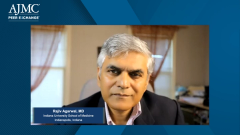
Establishing Care Pathways to Manage CKD and T2DM
Considerations for establishing balance for the care of patients with chronic kidney disease among all types of care settings.
Episodes in this series

Neil B. Minkoff, MD: Let me push on you a little based on something you said in terms of the referrals and so on. One of the things we often see in all different specialties is, for lack of a better term, who owns the patient? At what point does the care get transferred from primary care to specialist? Does it go back to the primary care? Obviously, this varies tremendously based on setting, the patient’s preferences, and so on. What do you guys think is the appropriate balance between primary care and specialty care for a patient with CKD [chronic kidney disease], especially one with type 2 diabetes?
Rajiv Agarwal, MD: Let me chime in here because I don’t think anybody owns the patient.The patient owns himself. We’re all servants to the care of the patient. Until we recognize that, we’ll always be battling who owns the patient. There are more times that I recommend spironolactone for a patient with HFrEF [heart failure with reduced ejection fraction] than a cardiologist does. And when I start the patient on spironolactone, it’s promptly stopped by the cardiologist, even though we have level 1a evidence that in HFrEF, spironolactone reduces all-cause mortality.
This is what’s happening in the United States. If you look at spironolactone adoption in heart failure for HFrEF in the United States, it’s the lowest in the civilized world. Why? Who owns the patient, the cardiologist for the heart? No. The patient has a condition, and he should get treated. This happens all the time, even for SGLT2 inhibitors. “The GFR [glomerular filtration rate] is now 20 mL/min, so I stopped the drug.” I asked, “Why? We started the drug when the GFR was 30 mL/min, you don’t need to stop it.” Well, “The package insert says we can’t use it below 25 mL/min.” I said, “No, you can start it.” It’s lack of education. You have to advocate for the patient, and if you don’t, I don’t think that we’ll make progress here because we’ll be fighting these wars about who owns the patient. Doing the right thing for the patient and advocating for the patient are key.
Neil B. Minkoff, MD: That’s why I tried to raise the issue, because it becomes a problem in terms of who considers themselves responsible for starting and stopping medications, like your example just now.
George L. Bakris, MD: Let me add to what Rajiv just said. He’s 100% right. I agree with everything Rajiv said. The answer to your question is the physician has to be wise enough to know what their limits are. What I’ve realized is people send me patients, not because they don’t know what to do—they do know what to do—but they’re scared to do it. They want me to do it and take responsibility for it in case anything goes wrong. They’re afraid of lawyers; there’s the problem. And they don’t understand how to interpret changes in serum creatinine, in spite of the fact that I and others have been trying to educate them for the last 20 years. We’ve failed. Or they just don’t want to do it. Or they understand it but are scared to do it. This is what goes on.
Eugene Wright Jr., MD: Neil, if I could comment on this, a first step would be the development, endorsement, and distribution of a common clinical care pathway that addresses raising awareness, screening, detection, management of CKD and type 2 diabetes, and referral. It tells you who to screen, with what tool, when to screen them, how often to screen them, how to manage what you find on the screening, and which patients should be referred. And in that referral are those patients for whom you’re uncomfortable treating the disease. But you can have a clear pathway that’s endorsed by the specialty societies. The cardiologists, nephrologists, primary care, and endocrinologists should be in on that. This would be a first step at overcoming some of the clinical inertia we see in primary care.
Rajiv Agarwal, MD: Neil, let me chime in on that. You live in the Boston area. We’ve had checklists there, we have systems medicines there. We now even call physicians providers. All of that needs to change. What has happened is we’ve looked at a health care system as a Toyota factory, and we’ve looked at it as systems and this and that. The individuals who we’re caring for have lost their voices because we start talking about ownership of the patient. Why? Because we think, “I’m the foreman of this factory. I get to do what I want.” No. We have to recognize that the patient is the center of the universe. We exist because the patient exists, and we’re helping the patient. We have to get the physician back to the care of the patient because we have to individualize care.
So many times you have 1 genital mycotic infection, and SGLT2 inhibitors are out. The patient won’t take that medicine no matter how much you advocate for it. You have to listen to the patient, and you have to listen hard and clear. Because if we start calling physicians providers instead of physicians, we’re taking away the ability for them to heal. They’re becoming prescribers and not physicians.
George L. Bakris, MD: Let me echo what Rajiv said. That’s a whole other thing. If we can get the businesspeople and lawyers out of medicine and go back to where we were in the 1980s, things would be better with what we know today applied to what was going on back then. That’s another topic for another discussion.
But to Gene’s point, with the exception of some of the stuff that you said at the very end, UpToDate [Pathways] tries to do this. We have subspecialty writers and all that. I oversee that. And people are going to read what they want to read. It’s not going to pop up, as Rajiv said very nicely. It’s not part of Epic, it’s not going to pop up on your screen and tell you what to do. People have to actually go. And then they’re going to read what they want out of it and leave the rest behind. It’s not easy.
Transcript edited for clarity.
Newsletter
Stay ahead of policy, cost, and value—subscribe to AJMC for expert insights at the intersection of clinical care and health economics.








































